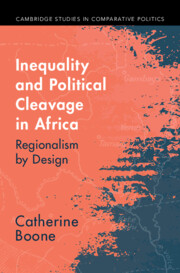Book contents
- Reviews
- Inequality and Political Cleavage in Africa
- Cambridge Studies in Comparative Politics
- Inequality and Political Cleavage in Africa
- Copyright page
- Epigraph
- Contents
- Figures
- Tables
- Preface and Acknowledgments
- 1 Economic Inequalities and Territorial Oppositions in African Politics
- 2 Region and Regionalism in African Politics
- 3 Endowment, Institutions, and Spatial Inequality
- 4 Regional Blocs and Bloc Voting in National Elections
- 5 Regional Hierarchies and Winning Coalitions
- 6 Territorial Oppositions in African Politics
- 7 Regionalism and the National Agenda
- 8 Conclusion
- Appendices
- References
- Index
- Cambridge Studies in Comparative Politics
4 - Regional Blocs and Bloc Voting in National Elections
Published online by Cambridge University Press: 18 April 2024
- Reviews
- Inequality and Political Cleavage in Africa
- Cambridge Studies in Comparative Politics
- Inequality and Political Cleavage in Africa
- Copyright page
- Epigraph
- Contents
- Figures
- Tables
- Preface and Acknowledgments
- 1 Economic Inequalities and Territorial Oppositions in African Politics
- 2 Region and Regionalism in African Politics
- 3 Endowment, Institutions, and Spatial Inequality
- 4 Regional Blocs and Bloc Voting in National Elections
- 5 Regional Hierarchies and Winning Coalitions
- 6 Territorial Oppositions in African Politics
- 7 Regionalism and the National Agenda
- 8 Conclusion
- Appendices
- References
- Index
- Cambridge Studies in Comparative Politics
Summary
Regional interests and tensions are manifest in regional bloc voting in multiparty elections (1990s–2010s). We present an electoral geography analysis of constituency-level voting in presidential elections in twelve countries from 1990 to 2015 (44 elections). We describe the economic attributes of the electoral blocs using forty rounds of DHS surveys for geocoded education and ethnicity data, nighttime luminosity, historical maps of producer regions, and raster data for population densities and contemporary crop production profiles. Most electoral blocs arise in rural regions that are wealthier, better educated, more densely populated, and more deeply incorporated into the national economy than other rural areas. Most are specialized in high-value export crops (or traded food crops.) Some have nonagricultural production profiles as labor-exporting or mining regions. Most coalesce within provincial-level administrative units. Almost all are multiethnic. The evidence is consistent with the argument that state institutions work to channel politics arising from uneven economic development into the national political arena. Microlevel mechanisms contributing to this outcome are related to interests, organizations, ideology, and actions of political agents and coalition-builders.
Keywords
- Type
- Chapter
- Information
- Inequality and Political Cleavage in AfricaRegionalism by Design, pp. 90 - 148Publisher: Cambridge University PressPrint publication year: 2024



